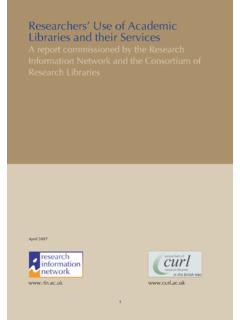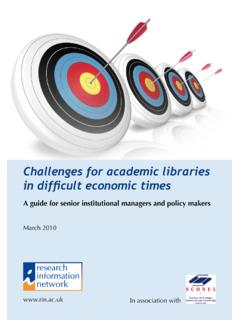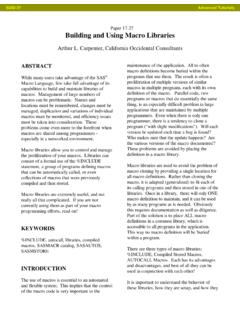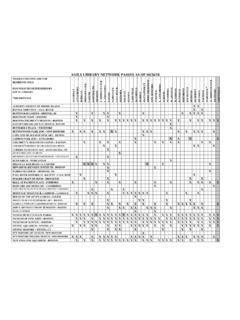Transcription of ARL NEW MEASURES Market Penetration in Research Libraries
1 ARL NEW MEASURESM arket Penetration in Research LibrariesPaul Kobulnicky and Carla StoffleI. Definition of markets in librariesThe concept of a Market has traditionally been associated with the sale of goodsand, further, to the location of the sale of goods .. the physical Market . The ideaof the physical Market leads directly to the set of consumers who are attracted tothat physical space to consummate their purchases of those goods that areexpected to be made available at that location. Those consumers then, byextension, become the Market . As transportation developed, the physical marketexpanded into many physical sites and the consumers as Market expanded to bedefined as the set of consumers of the several physical markets.
2 Proceedinglogically, as physical markets expand to near infinite sites, the concept of marketbecomes less that of individuals attracted to physical sites and more one of thetotal set of individuals who are potential consumers of the goods no matter Libraries , services are substituted for goods. Those services can be active(reference services or bibliographic instruction) or they can be passive to theconsumer (the development and maintenance of collections or the provision ofnetworked information). The Market for Libraries is the set of individuals whomight possibly take advantage of the services offered. In the most obvious casefor academic Research Libraries , the Market for Libraries are the students, facultyand staff of the institution of higher education.
3 In addition to representing acomplete Market , each of these constituencies (students, faculty and staff) definesmarket segments. Many academic Libraries also define other Market segmentssuch as alumni, members of the local community, members of other highereducation institutions, and members of general or specific scholarly of the keys to analyzing one s effectiveness in any given Market is toaccurately define that Market and its Market for Research Libraries becomes the set of individuals for whom thelibraries services are constructed for possible use and Market segments can bedefined around a finer granulation of groups for whom services are only can we define Market segments around members of the higher educationwith different status but we can also define Market segments around members ofdifferent academic disciplines.
4 Thus, while the total Market for library serviceswill include everyone for whom the library actively develops its services themarket segments can be defined in many ways and will likely resemble a matrixalong status and Definition of Market Penetration Market Penetration (also known as Market share) is a term that was developedto permit businesses to know what percentage of all possible sales wererepresented by their actual sales. In common practice, one MEASURES marketpenetration by measuring all real sales of a given good for a given period and thencomparing that total with the total of all sales of that specific good for the sameperiod made by one s own company.
5 It is important to measure marketpenetration because one s sales of a given good may go up, implying success, butactually not have increased as much as the total sales have increased. In this caseone s share of the Market has fallen and one s Penetration has actually the service sector, and especially in the non-profit service sector, marketpenetration is somewhat more complex to measure because the total Market isoften more than all of those who actually take advantage of the goods or servicesin a given period. The total Market also includes those who could take advantageof the Market . In many instances there is no simple metric, such as total sales, tolet us know what the total Market is and thus to let us calculate what part of it wehave captured.
6 In these cases, we have to make assumptions (which must beeventually tested) about our Market . We must make assumptions about the extentto which we expect all members of various communities to take advantage of ourservices and then measure the extent to which they Relation of Penetration to Library the Research library environment, Libraries construct services under theassumption that all or most members of the academic community require thoseservices. While we may make some differential expectation on members ofvarious Market segments (our expectations for university staff may be low, ourexpectations for graduate students may be very high) we still make assumptionsabout university need.
7 The idea behind measuring Penetration in the researchlibrary environment is to gain greater understanding of the extent to which ourcommunity makes any use of our services and, possibly, to measure both extentand quality of bring this matter into clarity requires some examples. Research Libraries buildcollections and services on the assumption that all members of the faculty requirethose services. If we were to consider all members of the faculty (carefullydefined) to be a Market segment then we would want to verify that all members ofthe faculty did indeed make use of the Libraries services. Most of us know that thisis not true for faculty and not even close to true for many other Market , knowing what percentage of the Market segment does use our servicesgives us a metric for evaluating, over time, the impact of changes in servicesand/or marketing techniques designed to attract a greater percentage of the marketsegment to the the Research university environment, the Market for library services is allpossible users of the Research library.
8 Many of these segments of this marketshould yield high Penetration . The faculty and graduate student segments shouldbe highly penetrated. The segment of the faculty and graduate students inHistory should be very highly penetrated. We would expect that undergraduateengineering majors are a segment that is very lightly penetrated. Likewise, wewould expect that alumni that are no longer enrolled would be a segment that isvery lightly penetrated, as we desire it to be. However, knowing through carefulanalysis, what our levels of Penetration actually are for a given segment allows usto target services to attempt to enhance or lessen that Measurement techniquesThere are two basic techniques for measuring Market Penetration in Libraries .
9 Thefirst is by survey instruments and the second is through usage statistics. Survey spermit Libraries to evaluate Market Penetration for a wide variety of services andmany different services simultaneously. Surveys can be total population for smallmarkets or for Market segments or can be statistically valid samples for largemarkets or across many Market segments. Usage statistics on the other hand, giveaccurate MEASURES of use but restrict studies only to those areas where datacollection is meaningful. One could set up library management software to recordall valid patrons and then keep track of those who circulated books during theyear.
10 At the end of the year, by status, one would have a good sense of the degreeto which the circulation service penetrated the entire Market of valid borrowersand similar Penetration of various segments by status and discipline. But it wouldonly measure circulation, a poor measure of total library impact for engineers of the tasks of the Market Penetration study group would be to design datacapture and evaluation instruments that would build a suite of Penetration studiesthat could be carried out in both longitudinal (temporal) and latitudinal (crossinstitutional) manners. In addition, much work would have to be done on thedefinition of standard markets and Market Impact of Penetration on missionResearch Libraries expect that the service they provide is essential to the work ofthe institution.








